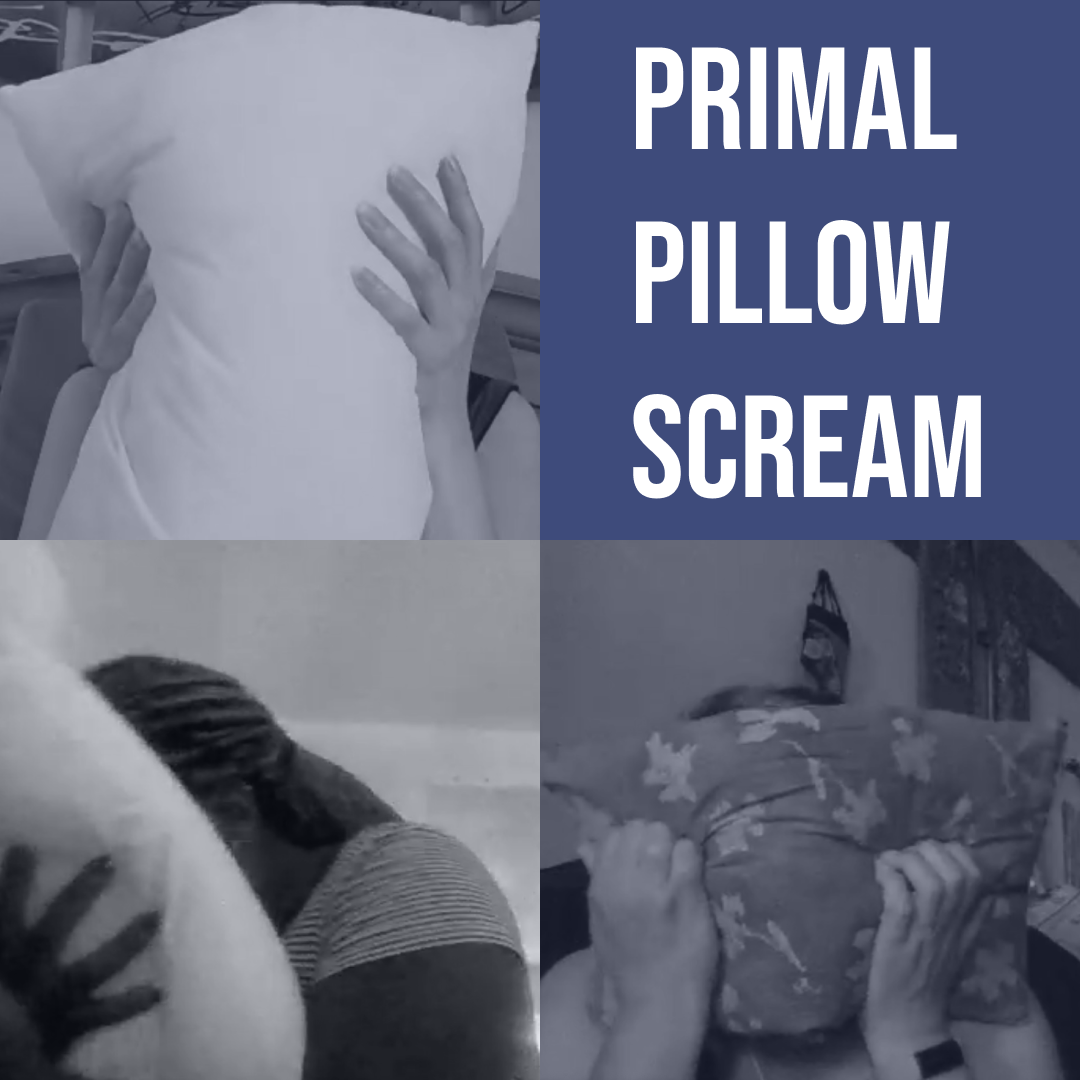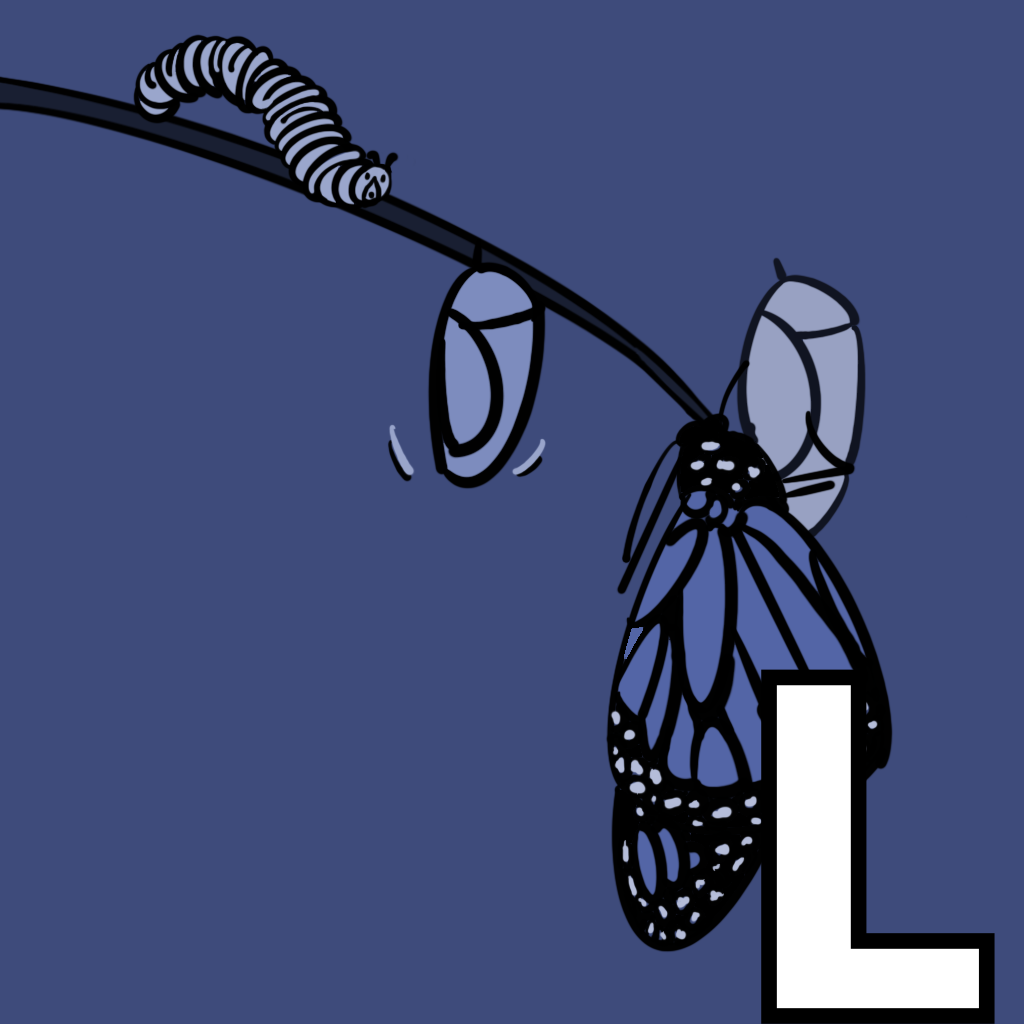ILLUSTRATION
The liminal definition that resonated most on this project is the one that speaks to being in a transitional or in-between state. Many visuals explaining the concept of liminality use a Venn diagram where the overlapping center represents being between two states. In nature, the process of metamorphosis provides another metaphor where chrysalis represents the liminal space between what was a caterpillar and what becomes the butterfly. The illustration draws on that reference.
INSPIRATION
When I chose the word liminal, I noticed all prior words have been nouns. If I had chosen not to break the pattern, I could have gone with word’s noun form liminality. I enjoy the sound of liminal more and it was an L word that resonated in a time between COVID and Post-COVID, injustice and justice, lost and found.
Liminal isn’t a common word and my only association with it was based on a book I read years ago. In the book, Liminal Thinking: Create the Change You Want by Changing the Way You Think, liminal thinking is described as, “the art of creating change by understanding, shaping, and reframing beliefs” and “finding, creating and using thresholds to create change.” In the book, and elsewhere where the concept of liminality is introduced, the Latin root of the word is defined as a threshold — a doorway, a journey, and a transition point.
Liminal spaces can be socio-psychological or physical. Physical spaces of liminality include elevators or stairs, hallways, lobbies, hotels, roads, and large empty spaces. In my research, I learned others on Reddit and Tiktok share their fascination with the liminal places of abandoned malls or other empty locations that evoke a mix of nostalgia and discomfort. Liminal spaces can be uncomfortable in part because they are not spaces that are meant for lingering. In socio-psychological contexts, they’re particularly uncomfortable because of the ambiguity and anxiety inherent in moving into the unknown without knowing what’s on the other side.
Rites of passage contain and address liminal spaces. Social rituals marking transition find themselves in many tribal societies and global religions but we’ve also embraced these in our secular lives. Rites of passage often make processes like the gradually visible transition from childhood to adulthood intentionally visible to reduce anxiety for those experiencing that liminal state.
For my most recent project at work, I designed a cohort-based job search coaching program to build career confidence in the 162 individuals who enrolled. The experience inspired the connection now around the liminality of being betwixt-and-between one’s old job and not yet into a new role. Transitions in professional contexts can feel more isolating than those in personal realms. It feels easier to give support to someone who is experiencing an upcoming marriage or a recent death. The outcomes are clearer; a wedding leads to a societally recognized end to single life and a funeral results in an understanding that a loved one will no longer be around. Particularly for someone who lost their job involuntarily, a community of support doesn’t gather synchronously to support that individual during the uncertain transition.
What if that wasn’t the case? I wondered what a rite of passage could look like for a liminal professional.
CREATION
With the concept of a rite of passage in mind, I invited a few job seekers to a last-minute workshop on career exploration and experimentation. I designed the workshop to flow across the three phases of rites of passage: separation (preliminal), transition (liminal), and incorporation (postliminal). This excerpt from Wikipedia explains the process well:
In the first phase, people withdraw from their current status and prepare to move from one place or status to another. "The first phase (of separation) comprises symbolic behavior signifying the detachment of the individual or group ... from an earlier fixed point in the social structure."[6] There is often a detachment or "cutting away" from the former self in this phase, which is signified in symbolic actions and rituals. For example, the cutting of the hair for a person who has just joined the army. He or she is "cutting away" the former self: the civilian.
The transition (liminal) phase is the period between stages, during which one has left one place or state but has not yet entered or joined the next. "The attributes of liminality or of liminal personae ("threshold people") are necessarily ambiguous."[7]
In the third phase (reaggregation or incorporation) the passage is consummated [by] the ritual subject."[8] Having completed the rite and assumed their "new" identity, one re-enters society with one's new status. Re-incorporation is characterized by elaborate rituals and ceremonies, like debutant balls and college graduation, and by outward symbols of new ties: thus "in rites of incorporation there is widespread use of the 'sacred bond', the 'sacred cord', the knot, and of analogous forms such as the belt, the ring, the bracelet and the crown."[9]
After I finalized the design, I emailed volunteers this list of items to have on hand:
- Few pages of paper
- Pen or pencil
- Scissors
- Yarn or string (ideally not red, black or white though any color you have on hand is fine) OR a bracelet you don’t typically wear
- Thick throw pillow or small cushion (bed pillow is also fine)
I created slides to prepare for the workshop but didn’t end up using them. Three volunteers attended and I didn’t want to break the feeling of intimacy by sharing our screen with anything but our faces. These slides give you a sense of the flow and content, minus the music, warm-up, and closing ritual.
So how did it go? I first had everyone respond to the question, “What’s a change you’ve made in your life that you’re proud of?” I came up with this question admittedly on the fly but it fit the session’s theme.
As we explored the separation phase, I had everyone write real, as in uncensored, resignation letters and then follow that up with a “primal” scream into the pillow. The pillow activity prompted some laughter and collective release to counter any tension from the letter-writing where anger and frustration were common emotions.

When we entered the transition phase, I asked that everyone take a piece of paper, hold it horizontally, and then fold it into thirds so there would be three tall columns. From there, I asked those who felt comfortable to close their eyes. I then lead a short visualization:
You’re walking down a long, dull hallway. You keep your focus on what’s ahead of you and you’re not even tempted to look back. You’re walking and there doesn’t seem to be anything of interest until you finally approach a row of three doors. Stand in front of these doors. Notice each door and be prepared to open each of them.
Asking them to open their eyes, I had them review their folded paper and in the first column, imagine that was door #1. Behind door #1 was a career that is similar to the career they have and the trajectory they’re on. I asked them to spend a few minutes drawing or writing key words that expressed what that experience was like. I repeated the exercise with slight variations of the prompt, with door #3 representing what a career would look like with no barriers (financial, geographic, etc.).
This particular exercise was inspired by a pilot I was involved with through New Sector Alliance. New Sector, in partnership with educators from Stanford, adapted some content from the Designing Your Life program, including an Odyssey Planning activity that covers three career paths over 5-year time horizons. When I attempted this activity on my own, prior to the pilot, I struggled with the 5-year planning. In the Designing Your Success pilot that engaged Year Up alumni, many participants found the 5-year time horizon challenging. Instead of mapping out what 5 years could look like on worksheets, I tried to get the participants of this workshop to tap into what would it feel like to experience looking through a door at a potential career.
To enter the incorporation phase, I asked that everyone pick the one door they felt most drawn to and would want to take one step toward exploring over the week. Every person chose to explore door #3, the one free of barriers which was essentially the dream career. We discussed what a reasonable step could look like to experiment with that over the week. I then asked the group to grab their string, cut it to an appropriate size, and tie it loosely around one of their wrists. These threaded bracelets would serve as reminders of their commitment for the week. We closed with feedback (I like…I wish…I wonder…) and a parting ritual.
As someone who designs and facilitates workshops in my day job and through Identity Lab, it felt mostly effortless to come up with activities to map against the rites of passage phases. It was more challenging to ensure I didn’t head into territory that bordered therapy or even religion. With the exercise that involved closing one’s eyes, for example, I introduced it in a way that someone could opt out if closing their eyes makes them uncomfortable or anxious. When it came to tying a piece of string around our wrists, I referenced the act in relation to a larger forget-me-not ring rather than comparing it to what you might find on a Kabbalist’s or Buddhist’s wrist.
Liminal changes are messy and emotional; I wanted to create space for that. At least one participant shared it was helpful to process her emotions to be able to move forward with a more positive perspective. In the future, I would need to make sure the facilitation was scripted in a way to avoid, or expertly address, triggering any possible past trauma. Thankfully, the workshop went well and participants asked if I would be offering this experience to others.
REFLECTION
Choosing this word is timely as I feel I’m in a liminal space betwixt and between what is next. UPDATE: One of the liminal career workshop participants shared she is still wearing the ribbon around her wrist! She said it reminds her that someone believes in her and to keep going.
CONNECTION(S)
For curated links and other content I couldn't fit into this post, subscribe to the email newsletter.
